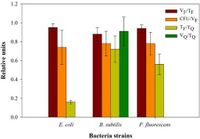In a bid to better understand the survival dynamics of airborne bacteria under environmental stressors, a recent study has explored how nitrogen oxides and light influence the viability of three common bacterial strains, namely Escherichia coli, Bacillus subtilis, and Pseudomonas fluorescens. Conducted in the ChAMBRe Atmospheric Simulation Chamber, researchers aimed to quantitatively assess the impact of pollutants on bacterial culturability, vital for both environmental health and public safety.
The study sheds light on the complex interactions between airborne microorganisms and environmental contaminants, addressing a critical public health concern. Atmospheric bioparticles, including bacteria, are increasingly acknowledged as a significant contributor to air quality issues, potentially leading to respiratory ailments and broader health complications.
During the experiments, the bacterial strains were aerosolized and subjected to two concentrations of nitrogen oxides: 900 parts per billion (ppb) and 1200 ppb, in both dark and simulated sunlight conditions. The chosen bacteria strains were recognized for their presence in the air due to soil resuspension and human activities.
Assessing bacteria cultures involved innovative methodologies, including collecting samples onto Petri dishes using an Andersen impactor at intervals following aerosol injection. This meticulous approach allowed researchers to compute the ratio of viable to total cells, revealing that more than 90% of the bacteria remained alive prior to their exposure in the chamber.
Remarkably, findings indicated that exposure to nitrogen dioxide (NO2) significantly diminished the bacteria’s survival rates, leading to culturability reductions that ranged from 50% to 70%. This drastic decline was seen at higher nitrogen oxide concentrations, particularly impacting B. subtilis and P. fluorescens, which were reduced by approximately 68% and 57%, respectively. In contrast, the lower concentration of nitrogen monoxide (NO) did not exhibit any notable effect on the bacteria, while the higher concentration diminished E. coli culturability by about 32%.
The experiments also observed that simulated sunlight conditions induced even more dramatic reductions in bacterial viability. Under sunlight exposure, E. coli experienced an 80% decline, followed closely by B. subtilis at 75% and P. fluorescens at an astounding 92%. This stark effect underscores the detrimental role of solar radiation, especially ultraviolet light, that can inactivate microorganisms and decrease their viability through mechanisms such as DNA damage.
Through these experimental setups, the ChAMBRe facility has demonstrated its potential as a powerful tool to study the interactions of pollutants and bioaerosols under controlled atmospheric conditions. Understanding these relationships is crucial not just to dissect the behaviors of airborne pathogens, but also to gauge their potential impact on community health, especially in environments where air quality is compromised.
The incorporation of these findings into broader public health strategies is essential, particularly with pathogens that enter a viable but non-culturable (VBNC) state, where they remain alive but are undetectable by standard laboratory methods. Such microbial communities can pose hidden threats as they retain virulence, raising concerns about infection dynamics during outbreaks.
Given the alarming rates of air pollution and its health ramifications, the insight gained from this research highlights an urgent need for continued studies that examine the thresholds and mechanisms by which pollutants and light can deactivate airborne bacteria. As anthropogenic activities contribute to worsening air quality, understanding their effects on bioaerosols will be indispensable for informed policy-making and public health decisions.
The study’s results prompt a call for future research that will explore not only how light and pollutants influence microbial survival but also tackle the broader implications of such findings in contexts like climate change, pollution mitigation, and public health enhancements.

